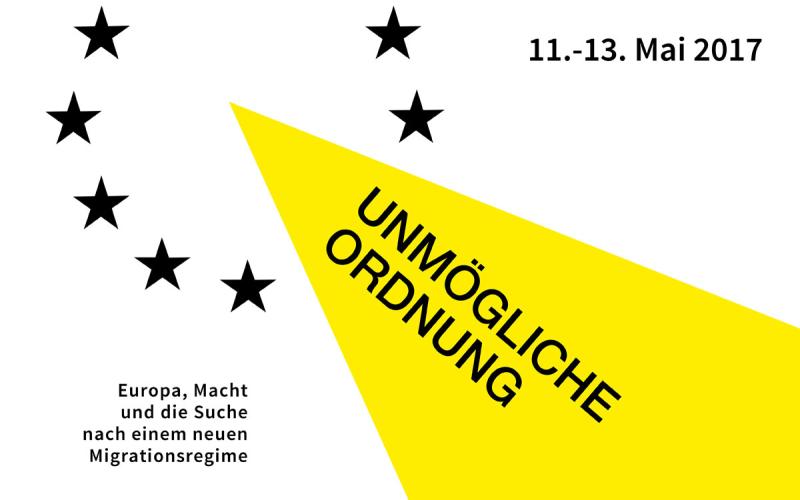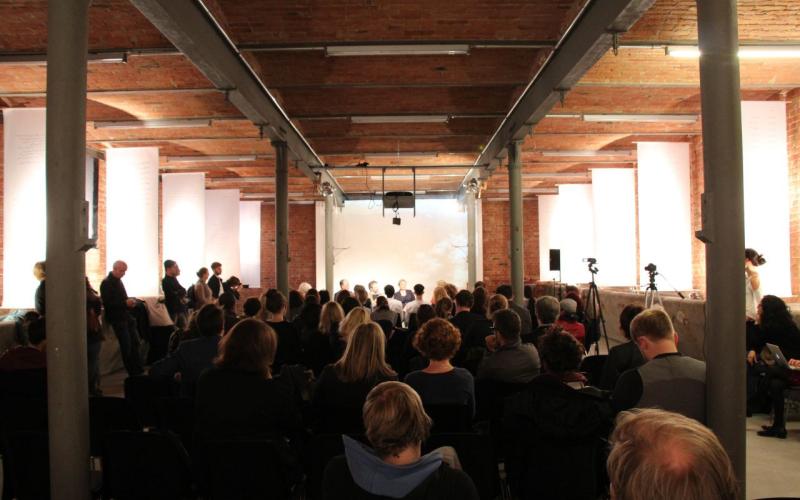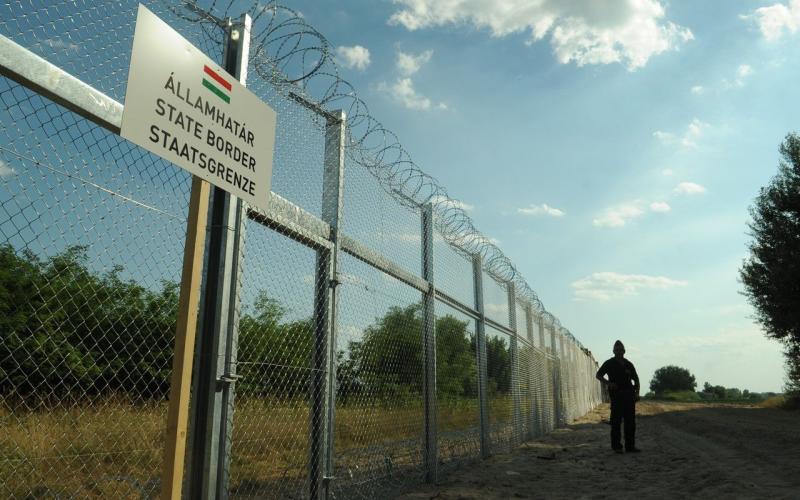Abstract: Panel VII (Crafting New Narratives), chaired by Kathrin Kollmeier (ZZF Potsdam), examined the interwoven nature of discourse, politics and identity. Christoph Rass (IMIS, Universität Osnabrück) opened the discussion with a presentation of his corpus linguistics research tracing discursive labels for migrants in Cold War Germany in connection with political events and migratory movements occurring at the time. Tobias Eule (Universität Bern) continued with a summary of his multi-sited ethnography in contemporary German Ausländerbehörden (Immigration Offices), noting that most employees no longer view the institution as a “deportation office,” but rather as a promoter of integration and enabler of long-term residence. Finally, Jan Plamper (Goldsmiths, University of London) emphasized the need for actor-centered historical narratives that redefine notions of national belonging in inclusive rather than ethno-biological terms. The three presentations highlighted the important role of language in both reflecting and (re)producing common conceptions of national, institutional, ethnic and religious collective identities.
Chaired by Kathrin Kollmeier, Panel VII asked how narratives on migration not only influence the way scholars conduct their research but also how humans, as active cultural agents, conceive of and perpetuate hierarchical social structures and categories of knowledge.
The first speaker, historian Christoph Rass (IMIS, Universität Osnabrück), discussed his approach to migration narratives with a paper entitled “Migration as a Threat: Discursive Configurations at the End of the Cold War.” From a corpus linguistics perspective, Rass traced the terminological history of label used on migrants and refugees in Germany through the Cold War to today. He argued that, throughout history, human beings have been in motion, and linguistic concepts have developed which designate certain types of mobility as migration in order to categorize and organize these movements. The prevalence of certain categories reflects and reproduces social attitudes toward migration in spatio-temporal communities.
Examining Cold War Germany as an example of the interdependence of discursive conditions, policies and social attitudes, Rass tracked the developments in the perceptions of migration from its initial portrayal as a source of short-term labor to how it is conceived today. In the 1950s, the term Gastarbeiter (guest workers) was prevalent, indicating that these individuals were commonly seen as a temporary workforce with a lower social status than that of their native “hosts.” Later, migrants were relabeled as Ausländer (foreigners) and, thereby, portrayed as different and alien. After Germany’s 1973 Anwerbestopp (recruitment ban), the term Ausländer was frequently used in reference to Germany’s Ausländerproblem (foreigner problem),and, in the process,conceptions of non-belonging extended beyond the labor market to include dialogues surrounding segregation.
As migration movements shifted in the 1970s and 1980s, the terminology commonly used to categorize migrants changed as well. The phrase Flüchtlingsproblem (refugee problem) was common in public discourse in the period from 1975 to 1982. Furthermore, Asylbewerber (asylum seeker), which emerged after 1975, took on a negative connotation with the term Asylant. The category Wirtschaftsflüchtling (economic refugee) was increasingly used to distinguish those who migrated to Germany for economic reasons and, thus, seemingly posed a threat to the economic welfare of Germany’s “native” population. In 1987, the terms Scheinasylant (bogus asylum seekers) and Asylbetrüger (asylum-cheaters) became common. These developments reveal a semantic trend in this period that individualized and criminalized asylum seekers in Germany.
The Asylkompromiss (Asylum Compromise) of 1992 brought with it rhetorical changes in regard to labeling practices. Higher percentages of Ausländer residing within Germany led to well-publicized debates questioning (and denying) Germany’s status as an immigration country. Rass concluded that the current focus in Germany on the securitization of migration is not a new one, but rather part of a historic pattern traceable through the evolution of terminology used to label immigrants and migration phenomena. This labeling tended to develop quickly from categorization to problematization, shifting the focus from structural causes of migration and integration to repetitive anxieties of the “host” society.
In the next presentation, Dr. Tobias Eule (Universität Bern) also investigated shifts in narratives of migration history in Germany, this time from the perspective of those working in contemporary Ausländerbehörden (Immigration Offices). Using multi-sited ethnographic data he gathered in 2009 and 2015/2016, Eule analyzed how state officials in the so-called foreigner offices in Germany conceptualize German immigration history through their institution's past.
From this data Eule identified four periods in the immigration officers’ understanding of their institution’s past. Firstly, there was the period of anarchy prior to the 1991 Ausländergesetz (Aliens Act), in which many decisions were left to the largely unguided discretion of the immigration officers. In the 1990s, several developments, including the influx of asylum seekers and Spätaussiedler, the 1991 Ausländergesetz, the 1993 Asylkompromiss, and the debates questioning Germany’s status as an immigration country, marked the beginning of the second period of the history of the Ausländerbehörde. During this time, migration law was viewed as a form of “police law” and immigration officers as law enforcement officers. The late 1990s and early 2000s witnessed a period of intermediate struggles for the Ausländerbehörden, but the main reactions to these social and political changes were to enact symbolic reforms and continue operations as usual. Most interestingly, Eule’s return to the field in 2015/2016 revealed a shift in the immigration workers’ fundamental outlook from one of control and restriction to one of enabling residence and “integration.” Most of the interviewees rejected the notion of the Ausländerbehörde as a deportation office, and while they expressed dissatisfaction, they also acknowledged that the way the offices currently operate is significantly better than it was in the past. Eule concluded that while institutional change may occur more slowly than political and legal change, there is a detectable shift in most immigration officers’ understanding of their own functional roles and a hopeful outlook for the future of the Ausländerbehörden.
The third and final speaker on Panel VII was Dr. Jan Plamper (Goldsmiths, University of London), whose work primarily focuses on the history of migration and of emotions. He opened his speech by stating, “Germany has a problem with narratives (of migration and its history).” While contemporary Germany is marked by a high degree of diversity, the commonly held ethno-biological understanding of nationhood demands a form of assimilative integration. In order to “belong,” immigrants are often expected to renounce their “cultures,” histories, and languages or, in other words, to become “more German than the Germans.” However, these demands make it almost impossible for migrants and others to fit into the ethnicized national collective identity. Plamper suggests that the way to deconstruct such essentialized national identities is through actor-centered narratives, including historical ones. These narratives should focus on individual migrants’ agency, and an effort should be made to emotionalize the stories in order to inspire empathy in the readers.
Plamper also proposed various alternatives to current labels that reinforce ethno-biological notions of nationhood. Firstly, to replace the term Ausländer, Plamper relied on Naika Foroutan’s concept of Neue Deutsche (New Germans), which refers to German citizens who immigrated or whose parents immigrated. Accordingly, Old Germans would take the place of hierarchical labels such as autochthone Deutsche (autochthonous Germans) or Biodeutsche (organic Germans). Furthermore, in order to describe the compositional complexity of contemporary societies, Plamper suggested we adopt Steven Vertovec’s “super-diversity.” Lastly, Plamper argued for a redefinition of the national Leitkultur (guiding culture) in a way that allows for the coexistence of particular identities, yet possesses a unifying set of characteristics holding the collective society together. Ultimately, he asserted that, through the dissemination of historical narratives, we need to move away from the current assimilative understanding of integration and embrace one in which inclusion and exclusion in pluralistic societies are not defined in ethnic terms. This diversity, in Plamper's view, should define the core of what we perceive as Leitkultur.
The three presentations incited an impassioned discussion among conference participants regarding the impact of terminology and labeling practices on conceptions of personal and collective identities. While Plamper argued that historical, emotionally charged terms like Leitkultur could be redefined in a positive, inclusive way, most of the audience agreed that new categories would only further essentialize migrants and reinforce static notions of national belonging. Panel VII, thus, proved to be the perfect end to the conference, tying together the three main themes that emerged in the previous discussions: (1) How are “inside” and “outside” understood, and how are these definitions shifting? (2) Which categories are used to define belonging and non-belonging, and what are the implications of these verbalizations for conceptions of identity and integration? and (3) How can we achieve a pluralistic, inclusive mode of expression?
Zitation
Kaitlyn Kennedy, Hana Khalaf, Crafting New Narratives. Panel VII , in: Zeitgeschichte-online, , URL: https://zeitgeschichte-online.de/themen/crafting-new-narratives



